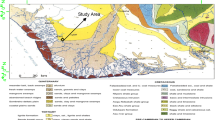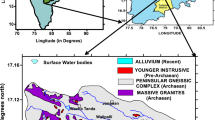Abstract
Distributed piles are often installed in the foundation pit in sandy soil before dewatering. Hydraulic conductivity should be estimated considering the block effect of piles on groundwater seepage. Research shows that the effective medium theory (EMT) could be used to calculate the equivalent hydraulic conductivity (k eq) of a heterogeneous medium with other material inclusions. In order to verify the applicability of EMT in an aquifer with piles, an experimental investigation is conducted. In this experiment, a sandy soil is considered as an aquifer and polyvinylchloride pipes are adopted as piles. Piles are distributed in rectangular and triangular layouts. The relationship between k eq of the aquifer and the volume replacement ratio is plotted for these two layouts. The results indicate that EMT could well predict k eq for the cases with the rectangular layout; however, for triangular layouts, the prediction becomes poor. To provide a better prediction of k eq of the aquifer with piles distributed in a triangular layout, a modified EMT (MEMT) is proposed, in which a correction factor is adopted considering different layouts of piles. The MEMT can provide better k eq predictions for an aquifer with piles in the triangular layout pattern than those obtained using the EMT.
Résumé
Des pieux distribués sont souvent installés dans une fosse de fondation dans des sols sableux avant dénoyage. La conductivité hydraulique doit être estimée en considérant l’effet de bloc des pieux sur le suintement des eaux souterraines. Les travaux de recherche montrent que la théorie du milieu effectif (TME) pourrait être utilisée pour calculer la conductivité hydraulique équivalente (k eq) d’un milieu hétérogène comprenant des inclusions d’autres matériaux. Afin de vérifier l’applicabilité de la TME dans un aquifère avec des pieux, une expérimentation a été menée. Dans cette expérience, un sol sableux est considéré comme aquifère et des pieux de polyvinylchloride sont retenus comme pieux. Les pieux sont distribués selon une configuration rectangulaire et triangulaire. La relation entre k eq de l’aquifère et le rapport du volume de remplacement est représentée sur un graphique pour les deux configurations. Les résultats indiquent que le TME permet de bien prédire k eq pour les cas de configuration disposition rectangulaire alors que pour la configuration triangulaire la prévision devient de moindre qualité. Afin d’obtenir une meilleure prévision de k eq de l’aquifère avec des pieux distribués selon une disposition triangulaire, un TME modifié (TMEM) est proposé, dans lequel un facteur de correction est adopté considérant les différentes configurations des pieux. La TMEM peut fournir de meilleures prévisions de k eq pour un aquifère avec des pieux selon une configuration triangulaire que pour les valeurs obtenues en utilisant le TME.
Resumen
En los pozos de cimientos en suelos arenosos se instalan pilotes distribuidos antes del drenaje, La conductividad hidráulica debe ser estimada considerando el efecto bloque de los pilotes en la filtración del agua subterránea. La investigación muestra que la teoría del medio efectivo (EMT) puede ser usada para calcular la conductividad hidráulica equivalente (k eq) de un medio heterogéneo con las inclusiones de otro material. Se realizó una investigación experimental para verificar la aplicabilidad de EMT en un acuífero con pilotes. En este experimento, un suelo arenoso se considera como un acuífero y se adoptan como pilotes caños de polivinilcloruro. Los pilotes están distribuidos en disposición rectangular y triangular. Se graficó la relación entre k eq del acuífero y el volumen de reemplazo para estas dos disposiciones. Los resultados indican que EMT puede predecir bien k eq para los casos con una disposición rectangular pero para la disposición triangular, la predicción se convierte en pobre. Se propone un EMT (MEMT) modificado para proveer una mejor predicción de k eq del acuífero con pilotes distribuidos en una disposición triangular, en el cual se adopta un factor de corrección considerando las diferentes disposiciones de los pilotes. El MEMT puede proveer mejores predicciones de k eq para un acuífero con pilotes en el diseño de la disposición triangular que aquellos obtenidos usando EMT.
摘 要
在进行基坑降水之前分布式桩基础经常会被打入到基坑的砂性土地层中。估算含有桩基础的含水层的渗透系数时需要考虑桩基础对地下水渗流的阻挡作用。发表的研究成果表明,有效介质理论(EMT)可以用来计算含有块状体的不均匀介质的等效渗透系数(k eq)。为了验证有效介质理论评估带有桩基础的含水层等效渗透性的有效性,本文应用室内试验进行了研究。试验中将颗粒较均匀的砂土作为含水层试验土体,采用PVC管模拟基桩。桩基的配置分别采用矩形布置与梅花形布置两种形式。试验结果给出了两种桩基布置方案中等效渗透系数(k eq)与体积置换率的相互关系。试验结果表明,考虑砂土体积置换率的有效介质理论可以有效地用来分析矩形布置的基桩础含水层的等效渗透系数,但对梅花形布置的基桩础含水层应用有效介质理论计算所得的等效渗透系数的结果有较大的偏差。基于对渗流路径的分析,提出了考虑有梅花形布置的桩基础存在时含水层等效渗透系数计算的修正方法(MEMT),给出了修正系数的计算公式。修正方法可以较好地预测有梅花形布置桩基础含水层的等效渗透系数。
Resumo
Estacas cravadas distribuídas são frequentemente instaladas nas escavações de fundações, em solos arenosos, antes da extração de água subterrânea. A condutividade hidráulica deve ser estimada considerando o efeito do bloco de estacas no escoamento da água subterrânea. A investigação mostra que a teoria do meio efetivo (EMT) poderia ser usada para calcular a condutividade hidráulica equivalente (k eq) de um meio heterogéneo com inclusões de outro material. A fim de verificar a aplicabilidade da EMT num aquífero com estacas cravadas, foi realizada uma investigação experimental. Nesta experiência, um solo arenoso é considerado como um aquífero e tubos de policloreto de vinil são adotados como estacas. As estacas são distribuídas em redes retangulares e triangulares. A relação entre a k eq do aquífero e a taxa de substituição do volume é representada para esses duas tipologias. Os resultados indicam que EMT poderia prever bem a k eq para os casos com o formato retangular, mas, para esquemas triangulares, a previsão torna-se pouco fiável. Para proporcionar uma melhor previsão da k eq do aquífero com estacas distribuídas num esquema triangular, é proposto um EMT modificado (MEMT), em que é adotado um fator de correção considerando diferentes esquemas de estacas. O MEMT pode fornecer melhores previsões de k eq, para um aquífero com estacas no padrão triangular, do que as obtidas com o EMT.
















Similar content being viewed by others
References
ASTM (2006) ASTM D 4254: standard test methods for maximum index density and unit weight of soils and calculation of relative density. American Society of Testing and Materials, West Conshohocken, PA
ASTM (2009) ASTM D7263: standard test methods for laboratory determination of density (unit weight) of soil specimens. American Society of Testing and Materials, West Conshohocken, PA
ASTM (2012) ASTM D698: standard test methods for laboratory compaction characteristics of soil using standard effort. American Society of Testing and Materials, West Conshohocken, PA
Bear J (1979) Hydraulics of groundwater. McGraw-Hill, New York
Bedient PB, Rifai HS, Newell CJ (1999) Groundwater contamination: transport and remediation, 2nd edn. Prentice Hall, New York
Begg SH, King PR (1985) Modeling the effects of shales on reservoir performance: calculation of effective vertical permeability. SPE Paper no. 13529, Society of Petroleum Engineers, Richardson, TX, pp 331–445
Bunn MI, Jones JP, Endres AL, Rudolph DL (2010) Effects of hydraulic conductivity heterogeneity on vadose zone response to pumping in an unconfined aquifer. J Hydrol 387(1–2):90–104
Carlson MA, Lohse KA, Jennifer C, McIntosh JC, McLain JET (2011) Impacts of urbanization on groundwater quality and recharge in a semi-arid alluvial basin. J Hydrol 409(1–2):196–211
Chai JC, Agung PMA, Hino T, Igaya Y, Cater JP (2011) Estimating hydraulic conductivity from piezocone soundings. Geotechnique 61(8):699–708
Chen JJ, Zhang LY, Zhang JF, Zhu YF, Wang JH (2013) Field tests, modification, and application of deep soil mixing method in soft clay. J Geotech Geoenviron Eng 139(1):24–34
Dagan G (1979) Models of groundwater flow in statistically homogeneous porous formations. Water Resour Res 15(1):47–63
Desbarats AJ (1992) Spatial averaging of hydraulic conductivity in three-dimensional heterogeneous porous media. Math Geol 24(3):249–267
Ding GP, Jiao JJ, Zhang DX (2008) Modelling study on the impact of deep building foundations on the groundwater system. Hydrol Process 22(12):1857–1865
Frippiat CC, Holeyman AE (2008) A comparative review of upscaling methods for solute transport in heterogeneous porous media. J Hydrol 362(1–2):150–176
Horpibulsuk S, Yangsukaseam N, Chinkulkijniwat A, Du YJ (2011) Compressibility and permeability of Bangkok clay compared with kaolinite and bentonite. Appl Clay Sci 52(1–2):150–159
Huang J, Han J, Oztoprak S (2009) Coupled mechanical and hydraulic modeling of geosynthetic-reinforced column-supported embankments. J Geotech Geoenviron 135(8):1011–1021
Jiao JJ, Leung CM, Ding GP (2008) Changes to the groundwater system, from 1888 to present, in a highly-urbanized coastal area in Hong Kong, China. Hydrogeol J 16(8):1527–1539
Jiao JJ, Wang XS, Nandy S (2006) Preliminary assessment of the impacts of deep foundations and land reclamation on groundwater flow in a coastal area in Hong Kong, China. Hydrogeol J 14(1–2):100–114
Powrie W, Preene M (1994) Time-drawdown behavior of construction dewatering systems in fine soils. Geotechnique 44(1):83–100
Ranjan S, Mysore SN, Kenneth LM, Gordon PB (2008) Investigations of pile foundations in brownfields. J Geotech Geoenviron 134(10):562–572
Roberts TOL, Preene M (1994) The design of groundwater control systems using the observational method. Geotechnique 44(4):727–734
Shen SL, Xu YS (2011) Numerical evaluation of land subsidence induced by groundwater pumping in Shanghai. Can Geotech J 48(9):1378–1392
Tan Y, Li MW (2011) Measured performance of a 26 m deep top-down excavation in downtown Shanghai. Can Geotech J 48(5):704–719
Tan Y, Wei B (2012) Observed behaviors of a long and deep excavation constructed by cut-and-cover technique in Shanghai soft clay. J Geotech Geoenviron 137(1):69–88
Wang JP, Xu YS, Ma L, Shen SL (2013) An approach to evaluate hydraulic conductivity of soil based on CPTU test. Mar Georesour Geotechnol 31(3):242–253. doi:10.1080/1064119X.2012.676154
Wen XH, Gomez-Hernandez JJ (1996) Upscaling hydraulic conductivities in heterogeneous media: an overview. J Hydrol 183(1–2):ix–xxxii
Xu YS, Ma L, Shen SL, Sun WJ (2012) Evaluation of land subsidence by considering underground structures penetrated into aquifers of Shanghai. Hydrogeol J 20(8):1623–1634
Xu YS, Shen SL, Du YJ (2009) Geological and hydrogeological environment in Shanghai with geohazards to construction and maintenance of infrastructures. Eng Geol 109(3–4):241–254
Xu YS, Shen SL, Du YJ, Chai JC, Horpibulsuk S (2013) Modelling the cutoff behavior of underground structure in multi-aquifer-aquitard groundwater system. Nat Hazards 66(2):731–748. doi:10.1007/s11069-012-0512-y
Zeng LL, Hong ZS, Cai YQ, Han J (2011) Change of hydraulic conductivity during compression of undisturbed and remolded clays. Appl Clay Sci 51(1–2):86–93
Acknowledgements
The research work described herein was funded by the National Nature Science Foundation of China (NSFC) (Grant Nos. 41102175 and 41072209). Financial support was also from Shanghai Jiao Tong University under the grant of the Starting Funding and New Star Plan (type B) of young faculty members. This financial support is gratefully acknowledged. The authors would like also to express their sincere thanks to the anonymous reviewers and associate editor for their detailed constructive comments, which were very helpful for improving the quality of the paper.
Author information
Authors and Affiliations
Corresponding authors
Appendix (Derivation of equivalent hydraulic conductivity)
Appendix (Derivation of equivalent hydraulic conductivity)
The seepage flow rate in an unconfined aquifer around a well is calculated as follows (Bear 1979; Bedient et al. 1999):
This assumes a radial axisymetric flow condition. However, in the test of this study, the flow condition is under a plane flow condition so that Eq. (12) cannot be directly applied for the test case and it should be modified. Figure 17 depicts the longitudinal sectional view of this test in a plane flow condition. The equivalent hydraulic conductivity, k eq, of the piled area is investigated. The hydraulic gradient between the two sides of the piled area is:
where i is the hydraulic gradient, dh is the groundwater level difference between the two sides of the piled area, and dx is the range of the piled area.
The seepage area is:
According to Darcy’s Law:
Assuming that the head h is measured above the reference plane taken as the bottom of the sand box; Q is the seepage flow.
where k eq is the hydraulic conductivity of piled area.
Integrating Eq. (16) from x 1 to x 2:
In this test, Q, a, x and h are all measured during the test.
Rights and permissions
About this article
Cite this article
Ma, L., Xu, YS., Shen, SL. et al. Evaluation of the hydraulic conductivity of aquifers with piles. Hydrogeol J 22, 371–382 (2014). https://doi.org/10.1007/s10040-013-1068-y
Received:
Accepted:
Published:
Issue Date:
DOI: https://doi.org/10.1007/s10040-013-1068-y





